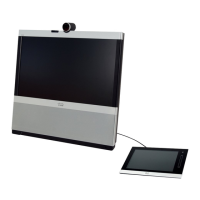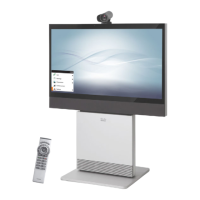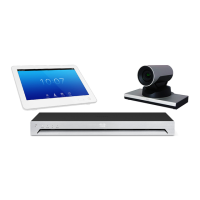43
Cisco TelePresence System EX90/EX60 Administrator guide
D14726.03 Cisco TelePresence System EX90-EX60 Administrator Guide TC4.0, December 2010.
Copyright © 2010 Cisco Systems, Inc. All rights reserved.
www.cisco.com
Advanced conguration
SerialPort Mode
Set the COM 1 serial port to be enabled/disabled.
Requires user role: ADMIN
Value space: <On/O>
On: Enable the COM 1 serial port.
O: Disable the COM 1 serial port.
Ex a m ple: SerialPort Mode: On
SerialPort BaudRate
Specify the baud rate (data transmission rate, bits per second) for the COM port on the codec. The
default value is 38400.
Connection parameters for the COM port: Data bits: 8. Parity: None. Stop bits: 1. Flow control: None.
Requires user role: ADMIN
Value space: <9600/19200/38400/57600/115200>
Range: Select a baud rate from the baud rates listed (bps).
Ex a m ple: SerialPort BaudRate: 38400
SerialPort LoginRequired
Determine if login shall be required when connecting to the COM port at the codec.
Requires user role: ADMIN
Value space: <On/O>
On: Login is required when connecting to the codec through COM port.
O: The user can access the codec through COM port without any login.
Ex a m ple: SerialPort LoginRequired: On
SIP Prole [1..1] URI
The SIP URI or number is used to address the system. This is the URI that is registered and used
by the SIP services to route inbound calls to the system. A Uniform Resource Identier (URI) is a
compact string of characters used to identify or name a resource.
Requires user role: ADMIN
Value space: <S: 0, 255>
Format: Compact string with a maximum of 255 characters.
Ex a m ple: SIP Prole 1 URI: "sip:rstname.lastname@company.com"
SIP Prole [1..1] DefaultTransport
Select the transport protocol to be used over the LAN.
Requires user role: ADMIN
Value space: <UDP/TCP/TLS/Auto>
UDP: The system will always use UDP as the default transport method.
TCP: The system will always use TCP as the default transport method.
TLS: The system will always use TLS as the default transport method. For TLS connections a SIP
CA-list can be uploaded using the web interface. If no such CA-list is available on the system then
anonymous Die Hellman will be used.
Auto: The system will try to connect using transport protocols in the following order: TLS, TCP,
U D P.
Ex a m ple: SIP Prole 1 DefaultTransport: Auto
SIP Prole [1..1] TlsVerify
For TLS connections a SIP CA-list can be uploaded using the web interface.
Requires user role: ADMIN
Value space: <On/O>
On: Set to On to verify TLS connections. Only TLS connections to servers, whom x.509 certicate
is validated against the CA-list, will be allowed.
O: Set to O to allow TLS connections without verifying them. The TLS connections are allowed
to be set up without verifying the x.509 certicate received from the server against the local CA-
list. This should typically be selected if no SIP CA-list has been uploaded.
Ex a m ple: SIP Prole 1 TlsVerify: Off
The SerialPort settings The SIP settings

